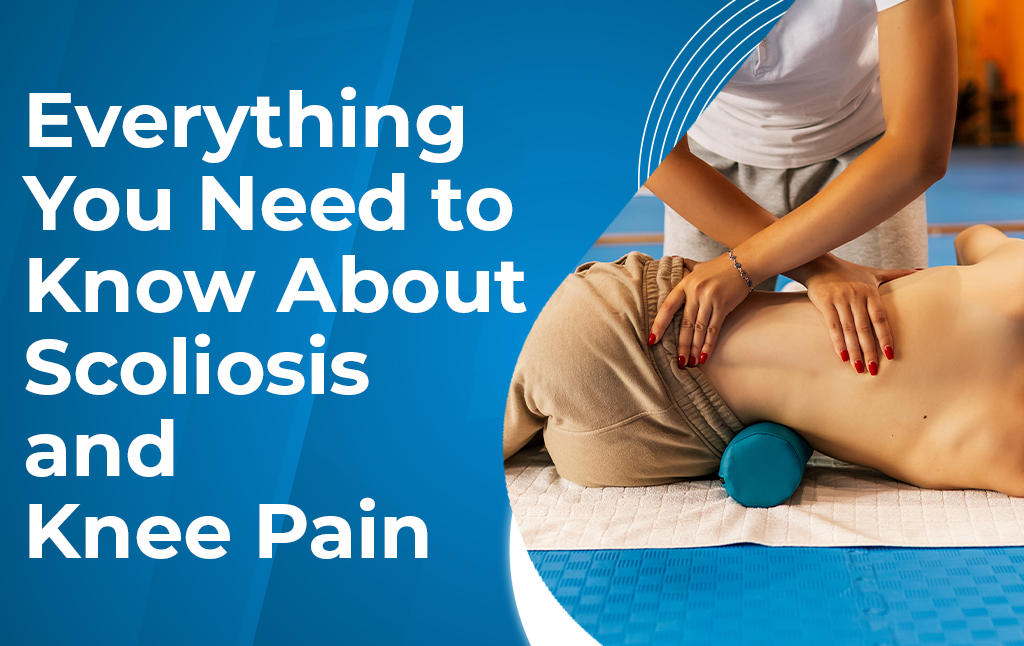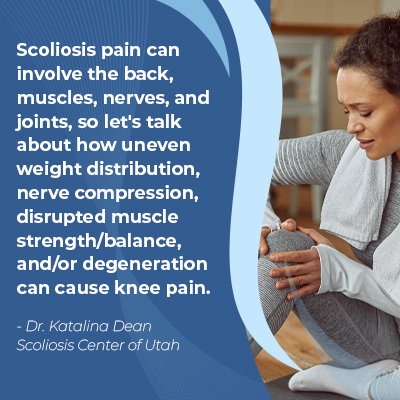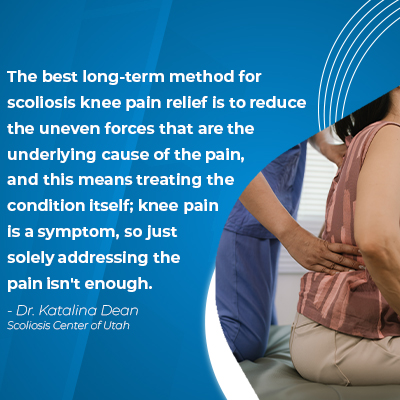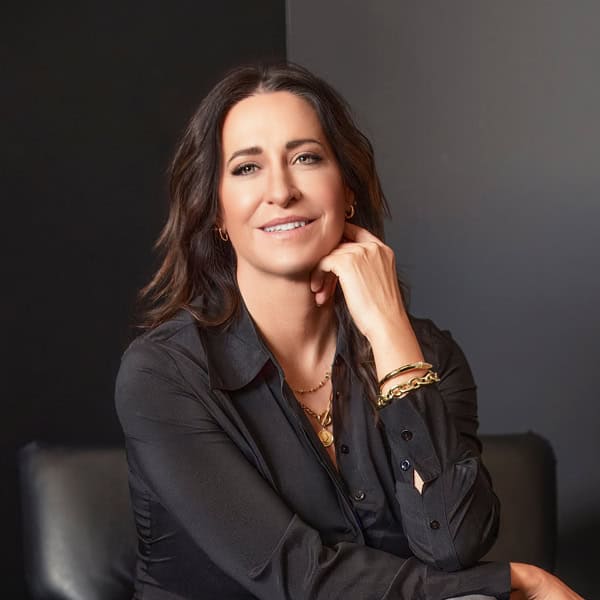Blogs
Everything You Need to Know About Scoliosis and Knee Pain

There are many things you need to know about scoliosis; although it’s a spinal condition, it doesn’t just affect the spine. Scoliosis can cause a number of effects felt throughout the body, and this is due to the condition’s uneven forces.
Scoliosis can cause knee pain due to uneven weight distribution, nerve compression, changes in muscle strength and balance, and/or the development of osteoarthritis. Scoliosis isn’t always painful but can cause back pain, nerve pain, muscle pain, and joint pain.
What you need to know about scoliosis knee pain, and other condition effects, is they can become worse over time, particularly if left untreated.
Scoliosis Progression
As a progressive condition, the nature of scoliosis is to get worse over time, and it’s growth that triggers progression.
Scoliosis is a structural spinal condition that causes an unnatural sideways-bending spinal curvature to develop, and the curve also rotates: a 3-dimensional condition.
Cases of scoliosis range widely in severity from mild to severe, and symptoms like pain can become more noticeable with increasing severity.
A spine that’s misaligned means its vertebrae aren’t stacked on top of one another in a healthy, neutral, and straight alignment, and this exposes the spine, its surroundings, and the entire body to a number of uneven forces.
A spine that’s misaligned can disrupt the entire body’s alignment from the head to the feet, and this can affect the body in a number of ways.
Scoliosis progression means the spine is becoming more misaligned, conditions are becoming more severe, and this makes them harder to treat without invasive surgical intervention.
Not all scoliosis patients experience pain; scoliosis doesn’t become a compressive condition until skeletal maturity has been reached and growth has stopped.
Scoliosis Pain
Common scoliosis symptoms include postural changes and pain. Once growth has stopped, the constant lengthening motion of the spine stops, and the compressive force of the spine’s unnatural bend and twist can cause pain.
In adults for whom scoliosis is compressive, pain is the main symptom that leads to assessment and diagnosis.
Scoliosis pain is caused by uneven pressure being exposed to the spine, its surrounding nerves, muscles, and the effects can be felt throughout the body.
 Scoliosis pain can involve the back, muscles, nerves, and joints, so let’s talk about how uneven weight distribution, nerve compression, disrupted muscle strength/balance, and/or degeneration can cause knee pain.
Scoliosis pain can involve the back, muscles, nerves, and joints, so let’s talk about how uneven weight distribution, nerve compression, disrupted muscle strength/balance, and/or degeneration can cause knee pain.
Uneven Weight Distribution Causing Scoliosis Knee Pain
As scoliosis disrupts posture, the body’s center of gravity also shifts and changes during movement and as the body is more affected.
Some of the postural changes scoliosis is known for include uneven shoulders, shoulder blades, hips, and a rib cage arch. These postural changes, plus a prominent lean to one side that often develops, can cause the body’s weight to be unevenly distributed throughout the lower body.
If the hips are uneven, this means one sits higher than the other, and this means that particularly during movement, the spine and body’s misalignment will disrupt its ability to evenly distribute the weight of the torso and upper body over the pelvis and throughout the lower body.
If weight isn’t evenly distributed over the pelvis during movement, the legs will experience uneven pressure that places extra strain on the knees, potentially causing pain, degeneration, and injury.
As mentioned, scoliosis can affect the spine’s surroundings as much as the spine itself, and in most cases, the area of the body located the closest to the affected spinal section will feel most of the condition’s direct and indirect effects.
So scoliosis that develops in the lumbar spine is going to mainly affect the lower back and body; although there are cases of compensatory curves where an unnatural curve in the lower back causes another unnatural bend to develop in the upper spine, in an attempt to counteract the uneven forces being introduced from below.
Nerve Compression Causing Scoliosis Knee Pain
The spine and brain work together as the body’s central nervous system and facilitates brain-body communication.
The spine contains 31 pairs of spinal nerves, so if the spine bends and twists unnaturally, it’s going to affect the nerves within and where they exit the spine and branch off throughout the body.
For example, a common complication of lumbar scoliosis includes sciatic nerve pain, and this is because the sciatic nerve starts in the lower back and projects down the back of the lower body and into the feet.
If the sciatic nerve is being compressed (exposed to uneven pressure and forces), it can become pinched, irritated, and/or inflamed and can cause a variety of symptoms felt throughout the lower body.
Nerve pain can vary from mild to severe, intermittent with flare ups to chronic and debilitating, and as the sciatic nerve extends down the back of the legs, it can also cause strange sensations and pain felt in the knees.
In most cases of sciatica, symptoms are felt down the left side of the body, so knee pain would most likely develop in the left knee.
Changes To Muscle Strength/Balance Causing Scoliosis Knee Pain
The spine needs support from its surrounding muscles, which is why a focus of non-surgical scoliosis treatment is on restoring core muscle strength and balance.
Just as scoliosis can impact the spinal nerves, it can also affect the spine’s surrounding muscles; when an unnatural curvature of the spine is pulling its surrounding muscles in different directions, it can cause muscle weakness and/or an imbalance to occur.
Unbalanced, weak, and or strained muscles in the back of the legs can cause knee pain, and uneven weight distribution can also cause uneven leg muscles as one side of the body has to work harder to support the spine.
Scoliosis Causing Osteoarthritis Knee Pain
Scoliosis can also cause the development of osteoarthritis in the spine and joints like the knees.
The unnatural spinal curvature puts extra stress on the spine’s vertebral joints, causing excessive and uneven wear and tear, and uneven weight distribution exposes uneven pressure to the joints of the lower limbs.
Uneven stress and force accelerates the breakdown of cartilage and joint tissues: a major factor in the development of osteoarthritis in the knees.
With knee osteoarthritis, there is a loss of cartilage which protects against friction during movement; bones rubbing up against one another will degenerate faster.
Treatment for Scoliosis Knee Pain
When it comes to being diagnosed with scoliosis, it’s important for patients to understand that not all cases of scoliosis require surgery; in fact, scoliosis can be highly responsive to non-surgical intervention.
Scoliosis knee pain, like all types of scoliosis pain and additional scoliosis symptoms, needs to be addressed with a proactive treatment plan.
There are never treatment guarantees, but the earlier scoliosis is diagnosed and treated, the more responsive it’s likely to be.
And the main issue with uneven wear and tear on the spine and joints of the body, including the knees, is that it causes excessive rates of degeneration, and while there is a certain amount of natural age-related joint degeneration to be expected, excessive rates cause pain and can cause additional stress and complications, such as the development of osteoarthritis.
Once degeneration starts in the knees, its effects can be difficult to reverse, but treatment started while scoliosis is still mild can prevent increasing stress and degeneration for better joint health.
Non-Surgical Scoliosis Treatment Disciplines
Here at the Scoliosis Center of Utah, my patients benefit from the complete customization of non-surgical treatment plans, and a proactive approach means starting treatment immediately following a diagnosis because as a progressive condition, most cases of scoliosis will get worse over time.
Treating scoliosis with non-surgical intervention means applying Chiropractic Biophysics®, a therapeutic exercise and rehabilitation program (ScoliBalance®), and 3-dimensional corrective bracing (ScoliBrace®)
 The best long-term sustainable method for scoliosis knee pain relief is to reduce the uneven forces that are the underlying cause of the pain, and this means treating the condition itself; knee pain is a symptom, so just solely addressing the pain isn’t enough.
The best long-term sustainable method for scoliosis knee pain relief is to reduce the uneven forces that are the underlying cause of the pain, and this means treating the condition itself; knee pain is a symptom, so just solely addressing the pain isn’t enough.
Conclusion
What you need to know about scoliosis is that as a progressive condition, experienced symptoms are likely to get worse, particularly in severe cases and/or if left untreated.
Scoliosis pain is most likely to be felt by adults because growth has stopped, making conditions compressive, and compression is the main cause of scoliosis pain.
Knee pain can develop as a symptom of scoliosis caused by uneven weight distribution, nerve compression, changes to muscle strength/balance, and/or the development of knee osteoarthritis.
The underlying cause of scoliosis knee pain are the uneven forces that scoliosis introduces to the body, so addressing the condition’s underlying structural nature is necessary.
Through the application of Chiropractic BioPhysics®, ScoliBalance® and corrective bracing, the misalignment of the spine may be improved, and this restores the balance and stability not just for the spine, but the entire body.
A spine that’s balanced and stable, with as much of its healthy curves restored as possible is the scoliosis treatment goal, and this may prevent and/or slow degenerative changes in the spine and joints, including the knees.

Dr. Katalina Dean
Dr. Katalina Dean is the founder and clinical director of Scoliosis Center of Utah, in Midvale, UT. Her team specializes in posture correction, spinal rehabilitation, and non-invasive scoliosis care and bracing.
Call Today
Do You Qualify for Care?
Schedule an Appointment Below
